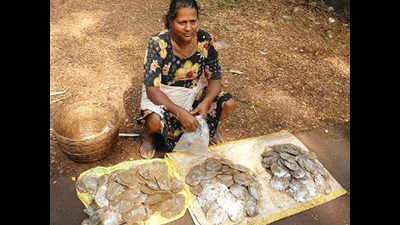Trending
This story is from October 15, 2019
Sea ranching to revive windowpane oyster population in Chicalim bay
With scientists developing a scientific model for artificial breeding of windowpane oysters, stakeholders along Chicalim bay are contemplating use of sea ranching practices to rejuvenate the depleting brood stock of this unique but endangered bivalve species.

BITS Pilani, Goa, in association with a former NIO scientist, has fabricated an aquarium-like device to breed bivalves
PANAJI: With scientists developing a scientific model for artificial breeding of windowpane oysters, stakeholders along Chicalim bay are contemplating use of sea ranching practices to rejuvenate the depleting brood stock of this unique but endangered bivalve species.
A few decades back, ‘mendios’ as they are popularly known, were being harvested in different parts of Goa.But pollution and a few other factors have affected their breeding status, reducing their population to a thin brood stock in Chicalim bay.
“Habitat restoration is time consuming. It is easier to use biotechnological practices to breed them artificially,” biotechnologist and former NIO scientist Anil Chatterji told TOI.
A day’s workshop organised by Chicalim Biodiversity Management Committee (BMC) in association with National Academy of Sciences, India, and BITS Pilani, Goa campus, was held to sensitise stakeholders on the importance of farming windowpane oysters, which are scientifically known as Placuna Placenta.
The incubator, which costs approximately Rs 4,000, can be accommodated in just over a square metre of space. The maintenance costs are also minimal.
Breeding involves collecting a dozen or more male and female oysters from the river for spawning under simulated conditions.
“The incubator temperature and the other parameters have to be maintained suitably for breeding,” Chatterjee said.
The breeding process entails minimal care for five to six months. “Once the oysters grow to an adult size, they will be released in the river. This will help restore the population in Chicalim bay,” Biswas said.
After many years, a rich crop of windowpane oysters in 2013 had raised hopes of a revival, but indiscriminate extraction scotched all hopes.
“These oysters and rich fish biodiversity on the Zuari are a source of livelihood for hundreds of local fishermen,” Rui Manuel Araujo, the chairman of Chicalim BMC said.
Prior to the release of incubated oysters, the scientists will identify suitable sites in Chicalim bay.
“Wide variation in salinity and temperature can affect the breeding cycle,” Chatterjee said.
Biswas has received a project from the Wildlife Trust of India to popularise sea ranching practices among the local fishermen. “The state forest department and other agencies have shown interest in the project,” Biswas said.
Chicalim bay is one of the few Asian habitats of the endangered windowpane oyster.
A few decades back, ‘mendios’ as they are popularly known, were being harvested in different parts of Goa.But pollution and a few other factors have affected their breeding status, reducing their population to a thin brood stock in Chicalim bay.
“Habitat restoration is time consuming. It is easier to use biotechnological practices to breed them artificially,” biotechnologist and former NIO scientist Anil Chatterji told TOI.
A day’s workshop organised by Chicalim Biodiversity Management Committee (BMC) in association with National Academy of Sciences, India, and BITS Pilani, Goa campus, was held to sensitise stakeholders on the importance of farming windowpane oysters, which are scientifically known as Placuna Placenta.
“In association with Chatterji we have fabricated a model of a three-storeyed aquarium-like device comprising a pump, tanks and a purifier system, to breed the bivalves,” Associate professor and scientist at BITS Pilani, Sumit Biswas told TOI.
The incubator, which costs approximately Rs 4,000, can be accommodated in just over a square metre of space. The maintenance costs are also minimal.
Breeding involves collecting a dozen or more male and female oysters from the river for spawning under simulated conditions.
“The incubator temperature and the other parameters have to be maintained suitably for breeding,” Chatterjee said.
The breeding process entails minimal care for five to six months. “Once the oysters grow to an adult size, they will be released in the river. This will help restore the population in Chicalim bay,” Biswas said.
After many years, a rich crop of windowpane oysters in 2013 had raised hopes of a revival, but indiscriminate extraction scotched all hopes.
“These oysters and rich fish biodiversity on the Zuari are a source of livelihood for hundreds of local fishermen,” Rui Manuel Araujo, the chairman of Chicalim BMC said.
Prior to the release of incubated oysters, the scientists will identify suitable sites in Chicalim bay.
“Wide variation in salinity and temperature can affect the breeding cycle,” Chatterjee said.
Biswas has received a project from the Wildlife Trust of India to popularise sea ranching practices among the local fishermen. “The state forest department and other agencies have shown interest in the project,” Biswas said.
Chicalim bay is one of the few Asian habitats of the endangered windowpane oyster.
End of Article
FOLLOW US ON SOCIAL MEDIA











